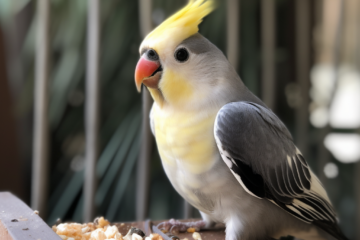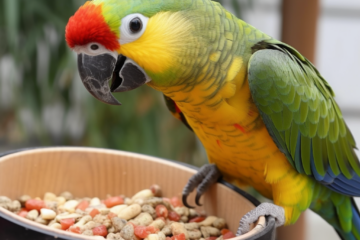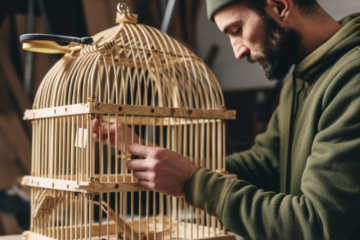Size matters more than you might think. The ideal cage should strike a balance between providing ample space for your feathered friend to spread its wings and ensuring coziness for nesting and sleeping. While a spacious cage, advertised for budgies, allows for natural movement and prevents feelings of confinement, an excessively large one can be overwhelming, leading to stress in your pet bird. So, how big should a parakeet cage be? Finding the sweet spot is key – not too small that it feels cramped nor too vast that it feels like a lonely expanse. Let’s explore the optimal dimensions, minimum cage size in inches, required to keep your chirpy budgie companion happy, healthy, and covered.
Understanding Parakeet Cage Size Essentials
Importance of Proper Cage Size
A budgie cage should be spacious with ½ inch bar spacing to ensure your feathered friend’s well-being. Providing a large enough cage is essential for parakeets to stay healthy and happy. They need ample space not just for flying but also for mental stimulation and overall contentment, with a minimum cage size, inches, and inch bar spacing. When considering the size of a parakeet cage, remember that inches and inch bar spacing directly impact their quality of life.
Parakeets are lively birds that enjoy spreading their wings and flitting around. A cramped space with a minimum cage size and inch bar spacing can lead to stress, boredom, and even health issues in these intelligent creatures. Picture yourself in a tiny room where you couldn’t move freely; wouldn’t that feel suffocating? Similarly, parakeets need room to stretch out, hop from perch to perch, play with toys, and exercise their natural behaviors.
Determining the Right Cage Size
The ideal size for a parakeet cage depends on how many birds will inhabit it. For one or two parakeets sharing the same enclosure, aim for a minimum width of 18 inches (46 cm), depth of 18 inches (46 cm), and height of 18 inches (46 cm). However, bigger is always better.
Consider opting for cages with horizontal bars spaced closely together rather than vertical bars; this design allows easy climbing and perching inside the cage. Ensure there’s enough room within the enclosure for various accessories like perches, toys, food dishes, water dispensers without making it feel overcrowded.
Ideal Dimensions for a Single Parakeet Cage
Minimum Cage Size
Experts recommend a minimum cage size of at least 18 inches in width, depth, and height. Providing the minimum cage size is crucial for your pet bird’s well-being as it allows them to move freely within their living environment. A spacious cage enables the parakeet to exercise, stretch its wings comfortably, and engage in natural behaviors like flying from perch to perch.
A larger cage not only meets the basic needs of your feathered friend but also offers additional benefits. With ample space available, parakeets can exhibit their natural behaviors more easily with a minimum cage size. For instance, having a roomy enclosure encourages them to spread their wings fully and fly short distances inside the cage. This freedom of movement promotes physical activity and contributes to overall health by reducing stress levels.
Height Consideration
In addition to width and depth measurements, the height of the cage plays a significant role in creating an enriching environment for your parakeet. Taller cages provide vertical space that allows for various levels where perches or toys can be placed vertically along with horizontal ones. When selecting a suitable cage height, consider choosing one that accommodates both horizontal bars for climbing opportunities and vertical elements such as ladders or swings.
-
Pros:
-
Encourages natural behavior
-
Promotes physical activity
-
-
Cons:
-
Requires more frequent cleaning due to increased space
-
Sizing Guidelines for Multiple Parakeets
Additional Space for Multiple Parakeets
When housing multiple parakeets, it’s crucial to provide adequate space in the cage. Each additional parakeet necessitates an extra 4-6 square inches of floor space to meet the minimum cage size. This ensures that each bird has ample room to move around comfortably within the enclosure while meeting the minimum cage size.
A larger cage for multiple parakeets is essential to meet their social and physical needs. By providing more space, you reduce stress levels among the birds and lower the chances of territorial conflicts breaking out. With a minimum cage size, your parakeets can establish their territories peacefully without feeling cramped or threatened by limited space.
Benefits of Providing Sufficient Space
-
Reduced Stress: A spacious cage allows each parakeet to have its own area and retreat when needed.
-
Minimized Conflicts: More room lessens the likelihood of fights over territory or resources.
-
Promotes Exercise: Larger cages encourage movement and activity, contributing to overall health.
Importance of Cage Bar Spacing for Parakeets
Importance of Bar Spacing
Bar spacing is crucial for your parakeet’s safety. The right spacing ensures they cannot escape or injure themselves.
Parakeets are small birds that can easily get hurt if the bar spacing on their cage is too wide. A recommended inch bar spacing for these birds is between ½ to ⅝ inch. This prevents them from sticking their heads out and getting trapped, or worse, injuring their delicate feet.
Preventing Injuries and Escapes
Wide bar spacing poses risks to your parakeet’s safety. If the bars are too far apart, there’s a chance your bird might try to squeeze through, leading to potential escape attempts or injuries. Imagine trying to walk on a tightrope; it’s challenging and dangerous for such tiny creatures.
To avoid any mishaps, always opt for cages with appropriate spacing, ensuring your feathered friend stays secure inside without the risk of injury or escape. It’s like wearing shoes that fit just right – you wouldn’t want them so loose that you trip or so tight that they hurt your feet.
General Considerations for Selecting a Parakeet Cage
Non-Toxic Materials
Parakeet cages should be made of non-toxic materials like stainless steel or powder-coated metal. These materials are safe for your bird and easy to clean, ensuring a healthy environment for your pet. Avoid cages with lead-based paints or zinc coatings as they can be harmful to parakeets.
It’s crucial to prioritize the safety and well-being of your parakeet by selecting a cage that is constructed from non-toxic materials. Stainless steel and powder-coated metal are durable options that also prevent rusting, providing a long-lasting home for your feathered friend.
Removable Trays and Grates
When choosing a parakeet cage, opt for one with removable trays and grates. This feature makes cleaning much easier as you can simply remove the tray, discard any waste, and wipe it down before reinserting it back into the cage. A clean environment is essential for maintaining your parakeet’s health.
Having removable trays in your parakeet cage simplifies the cleaning process significantly. It allows you to maintain cleanliness without causing stress to your bird or disrupting their daily routine. By opting for this feature, you ensure that both you and your pet have an enjoyable experience.
Playtop Area and Additional Perches
Consider selecting a parakeet cage that includes a playtop area or offers additional perches within the enclosure itself. These features provide extra enrichment opportunities for your bird, promoting physical activity and mental stimulation throughout the day. Parrots are intelligent creatures that thrive on interaction with their environment; therefore, having play areas enhances their overall well-being.
-
Opting for cages made of non-toxic materials ensures safety.
-
Choosing cages with removable trays simplifies cleaning routines.
-
Selecting cages with playtop areas enriches the living space of parakeets.
Essential Accessories for a Healthy Parakeet Habitat
Providing Adequate Perches
Parakeets need perches of different sizes and textures in their cage to maintain foot health. These perches also encourage exercise, helping keep your pet bird active and healthy. Natural wood or rope perches are excellent choices.
Including toys like bells, swings, and puzzles is crucial for keeping parakeets mentally stimulated. Toys provide entertainment and prevent boredom in your feathered friend. Rotating the toys regularly can keep your parakeet engaged and curious about its environment.
Proper Placement of Food and Water Dishes
When setting up your parakeet’s cage, ensure that food and water dishes are easily accessible. Placing them at a comfortable height will make it convenient for your pet bird to eat and drink without straining itself. Regularly clean these dishes to maintain hygiene.
Nighttime Coverage and Its Significance
Mimicking Natural Habitat
Covering the parakeet cage at night is crucial. It helps create a dark and quiet environment, mimicking their natural habitat. This promotes better sleep patterns for your feathered friend.
A covered cage provides a sense of security and privacy, just like how parakeets would feel safe in the wild under sheltered areas. By covering the cage with a breathable material, you ensure proper ventilation while maintaining darkness.
Promoting Quality Sleep
Ensuring that your parakeet gets quality sleep is essential for its overall well-being. A covered cage aids in blocking out any disturbances that might disrupt their rest during the night.
Parakeets are diurnal creatures, meaning they are active during the day and need undisturbed sleep at night to stay healthy and happy. By providing them with a cozy covered space, you contribute to establishing healthy sleeping habits.
Factors to Consider in Cage Design and Placement
Secure Door Latch
When choosing a cage for your parakeet, opt for one with a sturdy door latch. This feature is crucial to prevent any accidental escapes by your feathered friend. A secure door latch ensures that your parakeet stays safe inside its cage at all times.
It’s essential to prioritize the safety of your pet bird, and investing in a cage with a reliable door latch is key. By selecting a cage with this feature, you can have peace of mind knowing that your parakeet is secure within its living space.
Ideal Cage Placement
Avoid placing the cage near areas with drafts, direct sunlight, or high humidity levels. Drafts can make your parakeet uncomfortable and potentially lead to health issues. Direct sunlight can cause overheating and create an unpleasant environment for your pet bird. High humidity levels may also be detrimental to the well-being of your parakeet.
Consider the noise level of the surroundings when deciding where to position the cage. Loud noises can stress out birds and disrupt their sleep patterns. Selecting a quiet area for the cage will ensure that your parakeet feels safe and comfortable in its home environment.
Tips for Choosing the Right Cage
Research Options and Reviews
When choosing a cage for your parakeet, it’s crucial to research various options available in the market. Look for reviews from other bird owners to gather insights into the quality and suitability of different cages. Consider factors like durability, ease of cleaning, and overall functionality when reading these reviews.
Investing time in thorough research will help you make an informed decision and select a cage that meets both your needs and your parakeet’s requirements. By understanding what other bird owners have experienced with specific cages, you can avoid potential pitfalls and ensure that you are investing in a quality product.
Consider Your Parakeet’s Needs
One key factor to keep in mind when determining how big a parakeet cage should be is considering your bird’s size, activity level, and specific habits. For instance, if you have multiple birds or plan on expanding your flock in the future, opting for a large cage with ample space is essential.
Parakeets are active birds that require room to move around freely within their enclosure. Ensure that the bars of the cage are appropriately spaced so they cannot escape or injure themselves by getting stuck between them. Taking these aspects into account will help create a comfortable environment where your parakeet can thrive.
Summary
You’ve learned the ins and outs of choosing the right parakeet cage size. Remember, a spacious cage is crucial for your feathered friends’ well-being. Ensure there’s ample room for flying, perching, and playing to keep them happy and healthy. Don’t forget about bar spacing; it’s vital to prevent any escapes or injuries. Consider all aspects from dimensions to accessories to create a comfortable and safe habitat for your parakeets.
Now that you’re equipped with the knowledge on parakeet cage sizing, go ahead and revamp your bird’s living space. Take action today to provide your chirpy companions with a cozy and spacious home they’ll love!
Frequently Asked Questions
How important is the size of a parakeet cage?
The size of a parakeet cage is crucial for their well-being and happiness. A spacious cage allows room for exercise, stretching wings, and mental stimulation.
What are the ideal dimensions for a single budgies’ cage?
For a single parakeet, aim for a cage that is at least 18 inches in length, width, and height to provide ample space for movement and activities.
How do I determine the right bar spacing for my parakeet’s cage?
Choose a cage with bar spacing no wider than 1/2 inch to prevent your feathered friend from getting stuck or injured while ensuring proper ventilation within the enclosure.
Why is nighttime coverage significant in a parakeet habitat?
Nighttime coverage helps mimic natural light cycles, promoting restful sleep and overall well-being. Covering the cage also provides security and reduces stress levels during sleeping hours.
What factors should I consider when selecting accessories for my parakeet’s habitat?
When choosing accessories like perches and toys, prioritize safety by opting for materials free from toxins or small parts that could be ingested. Variety is key to keep your bird entertained.


